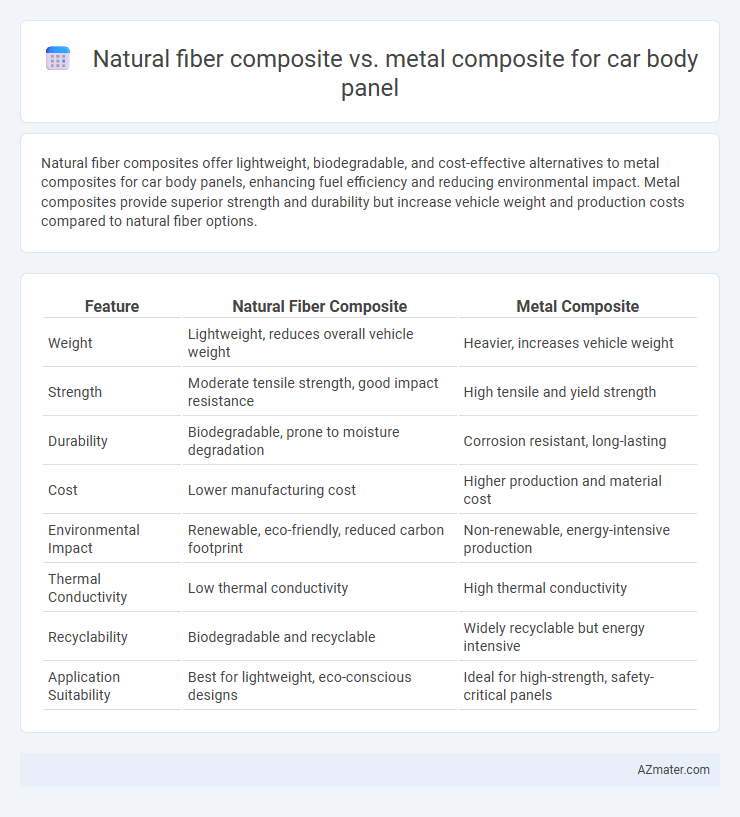Natural fiber composites offer lightweight, biodegradable, and cost-effective alternatives to metal composites for car body panels, enhancing fuel efficiency and reducing environmental impact. Metal composites provide superior strength and durability but increase vehicle weight and production costs compared to natural fiber options.
Table of Comparison
| Feature | Natural Fiber Composite | Metal Composite |
|---|---|---|
| Weight | Lightweight, reduces overall vehicle weight | Heavier, increases vehicle weight |
| Strength | Moderate tensile strength, good impact resistance | High tensile and yield strength |
| Durability | Biodegradable, prone to moisture degradation | Corrosion resistant, long-lasting |
| Cost | Lower manufacturing cost | Higher production and material cost |
| Environmental Impact | Renewable, eco-friendly, reduced carbon footprint | Non-renewable, energy-intensive production |
| Thermal Conductivity | Low thermal conductivity | High thermal conductivity |
| Recyclability | Biodegradable and recyclable | Widely recyclable but energy intensive |
| Application Suitability | Best for lightweight, eco-conscious designs | Ideal for high-strength, safety-critical panels |
Introduction to Car Body Panel Materials
Car body panels require materials that balance strength, weight, and durability to enhance vehicle performance and fuel efficiency. Natural fiber composites offer lightweight, corrosion-resistant alternatives with sustainability benefits, while metal composites provide higher structural integrity and impact resistance. Selecting between these materials involves evaluating factors such as mechanical properties, environmental impact, and manufacturing costs for optimal automotive design.
Overview of Natural Fiber Composites
Natural fiber composites for car body panels offer a sustainable alternative to traditional metal composites by utilizing renewable fibers such as flax, hemp, and jute embedded in polymer matrices. These composites deliver advantages including lower density, reduced weight, improved vibration damping, and enhanced environmental benefits like biodegradability and reduced carbon footprint. However, challenges remain in achieving comparable mechanical strength and durability to metal composites, necessitating ongoing research in fiber treatment and hybridization techniques.
Overview of Metal Composites
Metal composites for car body panels combine metals like aluminum or titanium with reinforcing materials such as ceramics or carbon fibers to enhance strength, stiffness, and corrosion resistance while reducing weight. These composites offer superior impact resistance and thermal stability compared to conventional metals, making them ideal for high-performance automotive applications. The integration of metal matrix composites contributes to improved fuel efficiency and vehicle safety by balancing durability with lightweight design.
Mechanical Properties Comparison
Natural fiber composites exhibit lower density and superior specific strength compared to metal composites, enhancing fuel efficiency and reducing overall vehicle weight. However, metal composites, such as aluminum or steel alloys, offer higher tensile strength, impact resistance, and durability under cyclic loading conditions, making them more suitable for structural integrity in car body panels. The mechanical behavior of natural fiber composites tends to be more anisotropic and sensitive to environmental factors, whereas metal composites provide consistent performance across varying conditions.
Weight and Fuel Efficiency Impact
Natural fiber composites significantly reduce car body panel weight by up to 30% compared to metal composites, enhancing overall vehicle lightness. This weight reduction directly improves fuel efficiency, with studies showing fuel savings of approximately 5-10% due to lower energy demands during acceleration and braking. The lower density and sustainable sourcing of natural fibers also contribute to decreased carbon emissions throughout the vehicle lifecycle.
Cost Analysis of Materials
Natural fiber composites for car body panels offer significant cost advantages over metal composites due to lower raw material prices and reduced energy consumption during production. Natural fibers such as flax or hemp are renewable, lightweight, and cheaper compared to metals like aluminum or steel, which have higher extraction and processing costs. Moreover, the waste management and recycling expenses for natural fiber composites tend to be less costly, contributing to an overall more economical material choice in automotive manufacturing.
Environmental Sustainability
Natural fiber composites for car body panels offer significant environmental sustainability advantages over metal composites, including lower carbon emissions during production and biodegradability at end-of-life. These composites utilize renewable resources such as hemp, flax, and kenaf, reducing reliance on non-renewable metals like aluminum and steel. Lightweight natural fiber composites also contribute to improved fuel efficiency and reduced vehicle emissions throughout the vehicle's lifecycle.
Durability and Maintenance
Natural fiber composites for car body panels offer lightweight properties and resistance to corrosion, reducing maintenance needs compared to metal composites prone to rust and denting. Metal composites provide superior impact resistance and higher durability under extreme conditions, but often require regular maintenance such as rust prevention and dent repairs. Advancements in natural fiber treatment and resin technology are improving the longevity of these composites, narrowing the durability gap with traditional metal materials.
Manufacturing Processes and Challenges
Natural fiber composites for car body panels require processes like resin impregnation and compression molding, offering benefits of lightweight and sustainability but face challenges in moisture absorption and inconsistent fiber quality. Metal composites involve techniques such as casting, forging, or sheet metal forming, providing superior strength and durability but often demand higher energy consumption and complex machining. Manufacturing natural fiber composites requires careful control of fiber-matrix adhesion, while metal composites confront issues with corrosion resistance and recycling complexities.
Future Trends in Car Body Panel Materials
Natural fiber composites are gaining traction in car body panel applications due to their lightweight properties, sustainability, and enhanced recyclability, which align with the automotive industry's shift toward eco-friendly materials. Metal composites, while offering superior strength and durability, face challenges in weight reduction and corrosion resistance, driving research into hybrid solutions that combine metal's mechanical performance with the environmental benefits of natural fibers. Future trends indicate a growing integration of bio-based resins and hybrid composites, optimizing strength-to-weight ratios and promoting circular economy principles in automotive manufacturing.

Infographic: Natural fiber composite vs Metal composite for Car body panel
 azmater.com
azmater.com